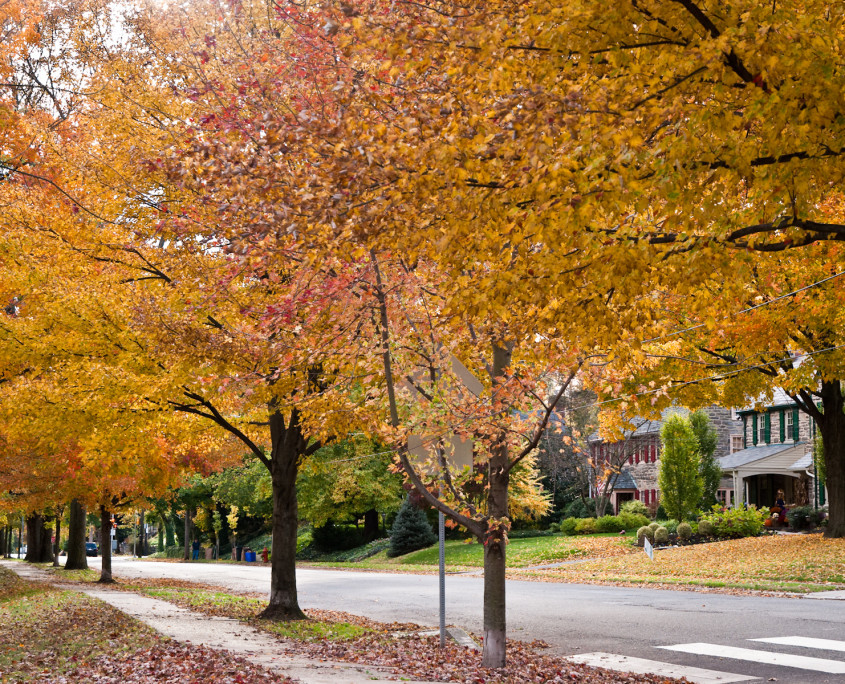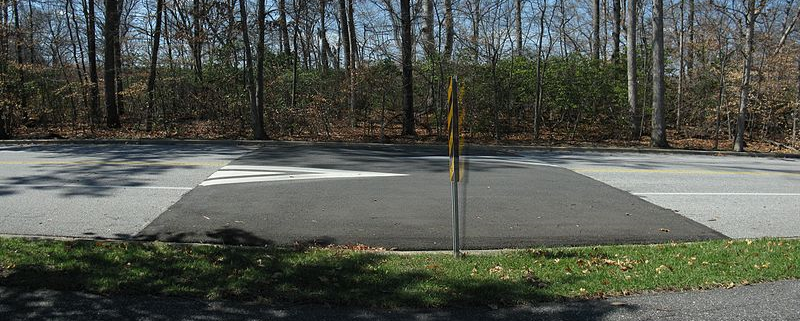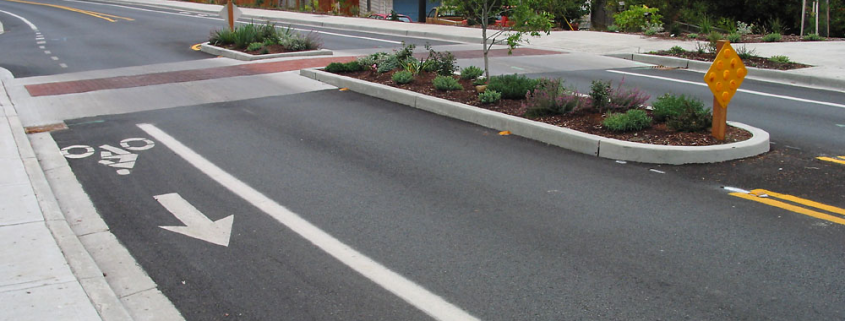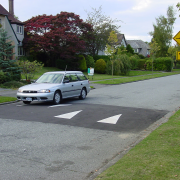Reduce Speeding with Speed Humps and Other Traffic Control Techniques
Many municipalities have a speeding problem in their neighborhood and wish to address complaints from their residents about safety concerns that result from excessive speed on quiet streets. While those residents often think a stop sign or reduced speed limit will correct the issue, studies indicate that unnecessary stop signs can actually increase speeds on local roads, and speed limits that are reduced below engineering standards are typically ignored.
In a previous post, we explained that the best way to reduce excessive speeding in a neighborhood is to combine education of the community with increased enforcement by police and the construction of engineering techniques that force drivers to slow down. There are many different traffic calming techniques, ranging from planting trees to constructing geometric roadway improvements. In this article, we describe some common techniques, their cost, and their effectiveness.
Photo by pml2008. Used under a Creative Commons license.

Street Trees
For a much lower cost than many of the other techniques discussed here, street trees have proven speed and accident reduction power. They also increase the aesthetic value of a neighborhood, reduce pollution, and maintain cooler temperatures, making them a very cost-effective improvement to a community.
Street trees are typically placed at 15-30 foot intervals and must be carefully located to ensure they provide clear sight lines and do not block street lights or utilities. When designed properly, street trees can reduce speeds between 3 to 15 miles per hour, according to studies cited by urban designer Dan Burden. They also reduce the number of crashes (between 5-20 percent in one study conducted in Toronto).
Though the exact reason for this speed and accident reduction is not known for certain, several theories exist. Some say the trees act as a visual wall that makes drivers more aware of a possible pedestrian presence. Others point to the calming effect trees have on us psychologically, suggesting that a calmer mood causes drivers to slow down.
Average cost: Since tree species vary by region, this cost can also vary widely. However, the average planting cost is between $250 to $650.
Photo by Robert Drudl. Used under a Creative Commons license.

Speed Humps
The most commonly used of the traffic calming measures, speed humps are rounded, raised areas of pavement that are placed every 300-600 feet on local roads. They typically include pavement markings and warning signage on the approaches, so that drivers are aware of their presence.
Speed humps can vary in height between 3 and 4 inches. Studies indicate that, if implemented correctly, these humps will cause drivers to reduce their speed anywhere between 4 to 23 miles per hour.
While well-designed speed humps are effective at reducing speeds on local roads, they should not be used on major collectors, bus routes or primary emergency response routes because they slow down emergency response vehicles (up to 3-5 seconds per hump for fire trucks and up to 10 seconds per hump for ambulances carrying patients).
Average cost: According to published information, the cost of speed humps can range from $1,000 to $6,900, and the average is approximately $2,500.
Photo by Andrew Bossi. Used under a Creative Commons license.

Speed Table (a.k.a. flat-top speed humps)
A speed table is similar to speed humps, but the humps are longer: They are typically designed so that the entire wheelbase of a vehicle can rest on top. Speed tables have a flat section on top and ramps on either side, and textured materials such as brick may be used on the flat section.
They do not produce as jarring a ride as speed humps, so they are preferred by emergency responders; however, drivers typically do not reduce their speed as much as they would with humps, as a result.
When used as raised crosswalks, speed tables increase the likelihood that drivers yield to pedestrians, so they are a good choice for increasing pedestrian safety in a neighborhood.
Average cost: According to published information, the cost of speed tables can range from $1,000 to $6,900, and the average is approximately $2,500.
Roundabout
Many people often think of traffic circles and roundabouts as being interchangeable, but they are not. Traffic circles are often more confusing and simply involve building a raised circular island in an intersection. A modern roundabout will also typically include a raised circular island, but it will include flared approaches. Flared approaches align the vehicle to the right of the center island so that merging of traffic is accomplished more easily, and it eliminates confusion. In addition, splitter islands with yield signs are typically included on each leg approaching the intersection, which helps drivers perceive a change in the roadway is coming and proceed with caution.
Roundabouts can reduce speeds between 15 to 25 miles per hour within the roundabout, and they are very effective at reducing crash frequency in residential neighborhoods (as much as 77 percent in one study) as well as crash severity.
Though new to Pennsylvania, they have been used safely and effectively throughout the U.S. in California, Florida, Maryland, and Washington. Pennsylvania has more than 20 roundabouts throughout the state, and another 40 are currently proposed. (You can watch traffic moving through one we designed at the intersection of North Boundary and Marshall Roads in the video above.) Despite opposition from some residents who aren’t familiar with the traffic pattern, roundabouts have been proven to be safer than traditional intersection designs, and they reduce emissions versus intersections with traffic lights and stop signs. They also eliminate the energy consumption associated with operating traffic signals. As a result, federal and state governments are encouraging engineers to use roundabouts wherever possible.
Due to their high cost, roundabouts are typically only considered when intersection improvements are already necessary, as opposed to being used merely as a device to slow traffic.
Average cost: Costs vary greatly, but typically range between $350,000 to $500,000.
Photo by Robert Drdul. Used here under Creative Commons license.

Center Island Narrowing
Sometimes called mid-block medians, these islands are located along the center line of a street, thereby narrowing the lanes of travel and causing drivers to slow down slightly. The islands may help to beautify the area with landscaping and can increase the safety of pedestrians by allowing them to cross one direction of traffic at a time (waiting in the island until the other direction is clear).
Emergency responders typically prefer these islands to other traffic calming devices, but they may reduce parking and driveway access. In addition, bicyclists do not like having to share a narrowed roadway with motorists.
Average cost: Costs range between $5,000 – $15,000.
Bulbouts
Bulbouts are curb extensions that can occur mid-block or at the intersections. They narrow the roadway, forcing drivers to slow down as much as 4 percent in some studies.
While emergency responders typically prefer these to other traffic calming devices like speed tables and speed humps, bicyclists do not like sharing a narrowed roadway with motorists. (However, bulbouts can be designed to include an island that allows bike riders to continue along the original curb line.)
Pedestrians also find bulbouts useful as they can be used to decrease intersection width, providing a shorter and safer crossing for people at the intersections. This, in turn, reduces pedestrian crossing times.
But bulbouts must be carefully designed to ensure adequate drainage, and delineators should be used to make them visible to snow plows.
Average cost: Bulbout costs vary greatly but generally range between $15,000 to $25,000.
Photo by Daniel Mayer. Used under a Creative Commons license.

Raised intersections
Raised intersections typically raise the pavement to sidewalk level over the entire intersection using sloped ramps onto a flat, often textured section in the middle, and then ramping back down to roadway height after the intersection.
They are very pedestrian-friendly and reduce intersection speed significantly, but the mid-block speed reduction is less than 10 percent. In addition, they must be carefully designed to ensure proper drainage.
Average cost: Raised intersections range in cost between $25,000 to $70,000.
Most of these traffic calming devices can be used in combination with each other, and, in fact, traffic calming devices should be planned and executed throughout a neighborhood, not on isolated streets. (If the devices are only used on one or two streets, drivers typically switch to alternate routes in order to avoid them, thereby shifting the speeding problem to a new location instead of eliminating it.)
Seeking the assistance of an experienced traffic engineer is crucial to the success of a traffic calming program because many factors must be considered in applying these techniques to ensure they do not cause unintended safety hazards, hamper emergency response, or create drainage problems.
Though the cost to implement these techniques may seem high, funding is available to help municipalities. In another post, we discuss how Act 89 Multi-Modal grants can be used to fund traffic calming projects like these.
For more information about implementing a traffic calming program in your community, contact Brian Emberg, P.E., our Senior Vice President and Director of Transportation Services.



